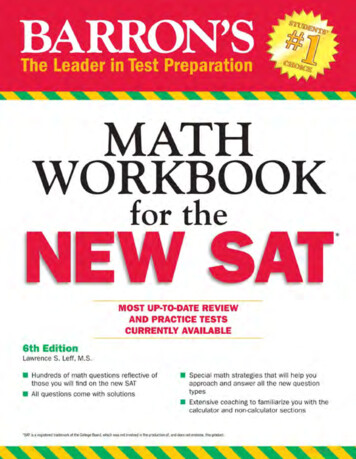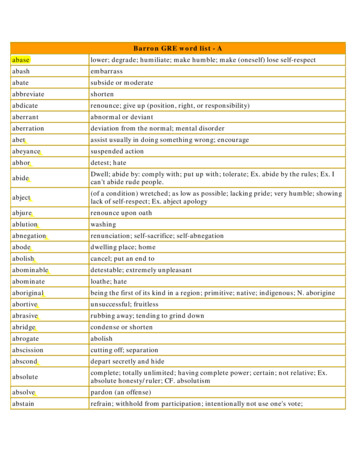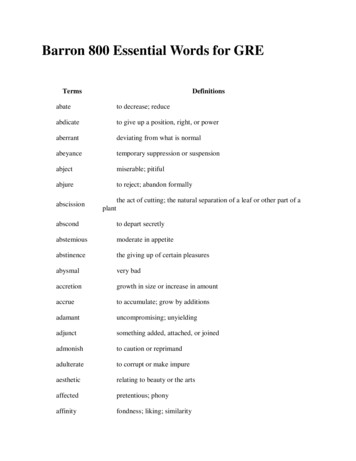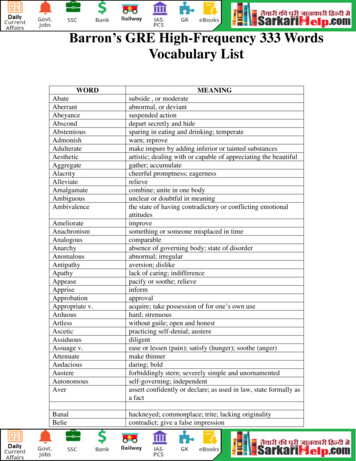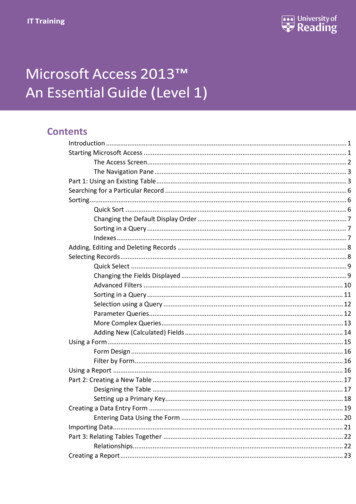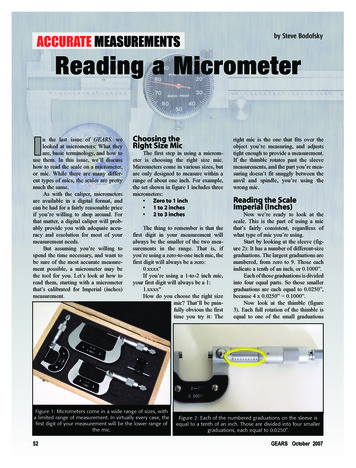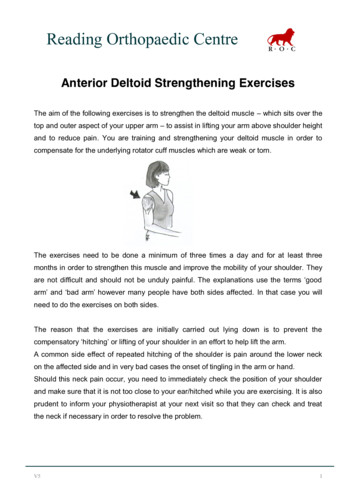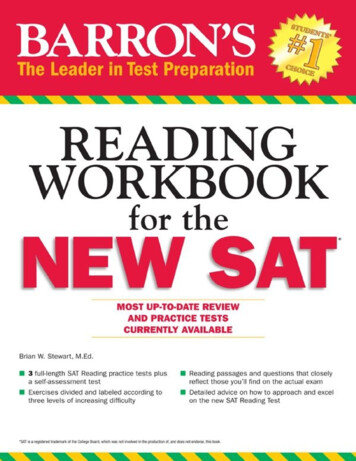
Transcription
DedicationDedicated to my wife Caitlin, my son Andrew, and my daughter Eloise—without your love and support,this book would not have been possible. I would like to especially thank my mom, my dad, Andy,Mitchell, Mercedez, Hannah, Alaina, Andrew, and Doug for their help with this undertaking. I am gratefulto everyone at Barron’s.Thanks so much to all of my students over the years—I have learned far more from you than you havelearned from me.
About the AuthorBrian W. Stewart is the founder and president of BWS Education Consulting, Inc., a boutique tutoring andtest preparation company based in Columbus, Ohio. He has worked with thousands of students to helpthem improve their test scores and earn admission to selective schools. Brian is a graduate of PrincetonUniversity (A.B.) and The Ohio State University (M.Ed.). You can connect with Brian atwww.bwseducationconsulting.com.
Copyright 2016 by Barron’s Educational Series, Inc.All rights reserved.No part of this publication may be reproduced or distributed inany form without the written permission of the copyright owner.All inquiries should be addressed to: Barron’s Educational Series, Inc.
250 Wireless BoulevardHauppauge, New York 11788www.barronseduc.comeISBN: 978-1-4380-6808-4First e-Book publication: March, 2016
ContentsIntroductionFAQs About the New SAT Reading TestDiagnostic TestSelf-Assessment GuideAnswers ExplainedChapter 1: Reading StrategiesChapter 2: Words in Context: Strategy and PracticePractice ExercisesAnswers ExplainedChapter 3: Graph Analysis: Strategy and PracticePractice ExercisesAnswers ExplainedChapter 4: Practice Exercises of Increasing DifficultyExercise AAnswers ExplainedExercise BAnswers ExplainedExercise CAnswers ExplainedPRACTICE TESTSPractice Test 1Answers ExplainedPractice Test 2Answers ExplainedPractice Test 3Answers Explained
Welcome to the e-Book version of the Reading Workbook for the New SAT!This e-Book may appear differently depending on the device you are using to view it on. Pleaseadjust your device accordingly.Throughout this e-Book, you may find several hyperlinks that will help navigate you through thecontent, bring you to helpful resources, and allow you to click between questions and answers.
IntroductionFAQs ABOUT THE NEW SAT READING TESTHow does the Reading section factor into the overall new SAT?The new SAT has two required sections—(1) Math and (2) Evidence-Based Reading and Writing. Eachsection will be scored between 200–800, making for a potential total score of between 400-1600. TheReading section and the Writing and Language section will contribute in equal measure to your overallEvidence-Based Reading and Writing score.What is the general format of the new SAT Reading section?It is a single section with these features: First test section 65 minutes long 52 questions (10 Fiction, 21 Social Studies, 21 Science).What will the reading passages be like? 5 passages total—each passage between 500 and 750 words for a total of around 3,250 words.– One fiction passage—a selection from U.S. or world literature – Two social studies passages—one from social science and one from a U.S. founding document or a selection from the “GreatGlobal Conversation” (e.g., a historical speech or essay) – Two science passages One of the passages will comprise two smaller passages that you will need to compare and contrastin the questions. Two graphs accompany the reading that you will need to analyze. The passages range in difficulty from early high school level to early college level.What are the questions like? 10 Words in Context questionsExample: As used in line 30, the word “advance” most closely means . . . 10 Command of Evidence questionsExample: Which option gives the best evidence for the answer to the previous question? 32 Analysis questionsExamples:– What statement best summarizes the passage?– The paragraph in lines 21–37 primarily serves to . . .– The narrator’s statement in lines 48–51 (“The primary . . . forecast”) most clearly implies that .
The questions for a given passage generally appear in the same order as the material in the passage(e.g., Question 1 is about lines 1–5, Question 2 is about lines 6–9, etc.). The questions are arranged in a random order of difficulty. There are 10–11 questions per passage.How is the new SAT Reading Test different from the old SAT Critical Reading Test?Old SAT Critical Reading TestA completely separate section for scoring purposesNew SAT Reading TestCombined with the Writing and Language section for the overall“Evidence-Based Reading and Writing” score1 large test section
3 shorter test sectionsSentence Completion questions—necessary to know lots of difficultvocabulary wordsWords in Context questions—more important to be able to determineappropriate word meaning in a given situationNo graphs; no “evidence” questionsGraphs to analyze; demonstrate command of text through evidencebased questionsQuestions require considerable reading timeEasier to determine what is being askedA quarter point guessing penaltyNO guessing penaltyHow can I use this book to prepare? IF YOU HAVE ONE DAY, look over the reading strategies, become familiar with the test directions andformat, and try a couple of passages under time constraints. IF YOU HAVE ONE WEEK, complete the diagnostic test, read the strategy chapter, and do targetedpractice on the types of passages and questions that give you difficulty. IF YOU HAVE A MONTH OR MORE, do everything in this book. Start with the diagnostic, read thestrategy chapter very carefully, and complete the practice exercises under time constraints, carefullyreflecting on your approach as you practice further.What can I do beyond this book to prepare? Practice with the other Barron’s books that have excellent sample reading tests, such as Barron’sNew SAT, Barron’s 6 Practice Tests for the New SAT, and Barron’s Strategies and Practice for theNew PSAT. Take rigorous courses in school, such as A.P. English Language and Composition, A.P. U.S. History,and International Baccalaureate Literature. Make reading a daily habit—talk to your local librarian about books that may suit your interests, readwell-written online journals and blogs, and download an e-reader to your smartphone so you canread good books no matter where you are. If you are ambitious, read publications that you find more challenging. The Best American series isgood for a wide variety of texts. If you have trouble with fiction, seek out books by authors likeEmily Dickinson, James Joyce, and Charles Dickens. If you struggle with social studies, readhistorical documents and publications like The Economist or The Atlantic. And if you find sciencechallenging, read publications like Science News and Scientific American, and check out onlineresources like Pubmed.gov. Use the free official practice resources available at KhanAcademy.org.The SAT Reading Test is a test of your reading skill, not any specific knowledge. You will do well on thistest if you improve your overall reading comprehension ability, which is exactly what this text is designedto do. Let’s get started!
**Remember, since this is an e-Book, all directions on the Diagnostic and Practice Tests may looksimilar to those you may see on test day, but you will need to write your answers and any otherresponses separately. Answer Sheets are for reference only.Good luck!
Diagnostic Test
65 MINUTES, 52 QUESTIONSDirections: Each passage or pair of passages is accompanied by several questions. After readingthe passage(s), choose the best answer to each question based on what is indicated explicitly orimplicitly in the passage(s) or in the associated graphics.Questions 1–10 are based on the following reading selection.The following is an excerpt from Jane Austen’s Mansfield Park, 1814. The novel’s protagonist, FannyPrice, returns home after many years of living with her wealthy relatives at Mansfield Park.Line(5)(10)(15)(20)(25)(30)(35)William was gone: and the home he hadleft her in was—Fanny could not conceal itfrom herself—in almost every respect thevery reverse of what she could have wished.It was the abode of noise, disorder, andimpropriety. Nobody was in their right place,nothing was done as it ought to be. She couldnot respect her parents as she had hoped.On her father, her confidence had not beensanguine, but he was more negligent of hisfamily, his habits were worse, and his mannerscoarser, than she had been prepared for.He did not want abilities; but he had no curiosity,and no information beyond his profession;he read only the newspaper and thenavy-list; he talked only of the dockyard, theharbour, Spithead, and the Motherbank; heswore and he drank, he was dirty and gross.She had never been able to recall anythingapproaching to tenderness in his formertreatment of herself. There had remainedonly a general impression of roughness andloudness; and now he scarcely ever noticedher, but to make her the object of a coarsejoke.Her disappointment in her mother wasgreater: there she had hoped much, andfound almost nothing. Every flatteringscheme of being of consequence to her soonfell to the ground. Mrs. Price was not unkind;but, instead of gaining on her affection andconfidence, and becoming more and moredear, her daughter never met with greaterkindness from her than on the first day ofher arrival. The instinct of nature was soon
(40)(45)(50)(55)(60)(65)(70)(75)(80)satisfied, and Mrs. Price’s attachment had noother source. Her heart and her time werealready quite full; she had neither leisure noraffection to bestow on Fanny. Her daughtersnever had been much to her. She was fondof her sons, especially of William, but Betseywas the first of her girls whom she had evermuch regarded. To her she was most injudiciouslyindulgent. William was her pride;Betsey her darling; and John, Richard, Sam,Tom, and Charles occupied all the rest of hermaternal solicitude, alternately her worriesand her comforts. These shared her heart;her time was given chiefly to her house andher servants. Her days were spent in a kindof slow bustle; all was busy without gettingon, always behindhand and lamenting it,without altering her ways; wishing to be aneconomist, without contrivance or regularity;dissatisfied with her servants, without skillto make them better, and whether helping,or reprimanding, or indulging them, withoutany power of engaging their respect.Of her two sisters, Mrs. Price very muchmore resembled Lady Bertram than Mrs.Norris. She was a manager by necessity, withoutany of Mrs. Norris’s inclination for it, orany of her activity. Her disposition was naturallyeasy and indolent, like Lady Bertram’s;and a situation of similar affluence anddo-nothingness would have been much moresuited to her capacity than the exertions andself-denials of the one which her imprudentmarriage had placed her in. She might havemade just as good a woman of consequenceas Lady Bertram, but Mrs. Norris would havebeen a more respectable mother of nine childrenon a small income.Much of all this Fanny could not but besensible of. She might scruple to make useof the words, but she must and did feel thather mother was a partial, ill-judging parent,a dawdle, a slattern, who neither taught norrestrained her children, whose house wasthe scene of mismanagement and discomfortfrom beginning to end, and who had notalent, no conversation, no affection towards
herself; no curiosity to know her better, nodesire of her friendship, and no inclination(85) for her company that could lessen her senseof such feelings.Fanny was very anxious to be useful, andnot to appear above her home, or in any waydisqualified or disinclined, by her foreign(90) education, from contributing her help to itscomforts, and therefore set about working forSam immediately, and by working early andlate, with perseverance and great despatch,did so much, that the boy was shipped off at(95) last, with more than half his linen ready. Shehad great pleasure in feeling her usefulness,but could not conceive how they would havemanaged without her.1. What best describes what happens in the passage as a whole?(A) A character discusses her troubled thoughts with close family and friends.(B) A character analyzes her observations relative to her experiences and expectations.(C) A character reflects on how she could be a better contributor to her immediate family.(D) A character considers her economic station in a strongly hierarchical society.2. Fanny’s overall attitude toward her parents is best described as (A) justified affection.(B) unjustified jealousy.(C) unwarranted disrespect.(D) warranted disappointment.3. The first paragraph characterizes Fanny’s father’s intellectual interests as (A) relevant and interesting.(B) coarse and joking.(C) overly pragmatic.(D) arrogantly erudite.4. As used in line 35, the phrase “instinct of nature” most closely means (A) maternal feeling.(B) desire for survival.(C) thirst for acceptance.(D) sense of justice.5. The more that Fanny is around her mother, the more her mother treats her with (A) abuse.(B) affection.(C) inattention.(D) encouragement.6. Which option gives the best evidence for the answer to the previous question?(A) Lines 19–21 (“She . . . herself”)(B) Lines 33–35 (“her . . . arrival”)(C) Lines 55–58 (“without . . . respect”)
(D) Lines 61–63 (“She . . . activity”)7. When Fanny returns to live with her parents, she is eager to be (A) an idealistic martyr.(B) an economical innovator.(C) an empowering mentor.(D) a helpful contributor.8. Which option gives the best evidence for the answer to the previous question?(A) Lines 5–8 (“It . . . hoped”)(B) Lines 37–43 (“Her heart . . . regarded”)(C) Lines 69–73 (“She might . . . income”)(D) Lines 87–91 (“Fanny . . . comforts”)9. As used in line 46, the word “occupied” most closely means (A) stayed.(B) resided.(C) dwelled.(D) engaged.10. The third paragraph (lines 59–73) suggests that Mrs. Norris is (A) more capab
New SAT, Barron’s 6 Practice Tests for the New SAT, and Barron’s Strategies and Practice for the New PSAT. Take rigorous courses in school, such as A.P. English Language and Composition, A.P. U.S. History, and International Baccalaureate Literature. Make reading a daily habit—talk to your local librarian about books that may suit your interests, read well-written online journals and .
